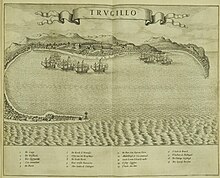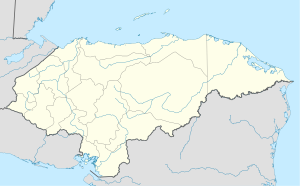Trujillo, Honduras
Trujillo | |
|---|---|
Municipality | |
 Trujillo Cathedral | |
| Coordinates: 15°55′N 86°00′W / 15.917°N 86.000°W | |
| Country | |
| Department | Colón |
| Government | |
| • Mayor | Héctor Mendoza |
| Area | |
| • Municipality | 955 km2 (369 sq mi) |
| Population (2023 projection)[1] | |
| • Municipality | 71,106 |
| • Density | 74/km2 (190/sq mi) |
| • Urban | 31,464 |
Trujillo is a city, with a population of 22,750 (2023 calculation),
The
Trujillo has received plenty of attention as the potential site of a proposed Honduran charter city project,
History
Colonial period

The history of the modern town begins in 1524, shortly after the

Under Spanish rule Trujillo became the capital of Honduras, but because of its vulnerability the capital was changed to the inland town of Comayagua. The fortress, Fortaleza de Santa Bárbara (El Castillo), which sits on the bluff overlooking the bay, was built by the Spanish around 1550. Nevertheless, it was inadequate to really defend Trujillo from pirates—the largest gathering of pirates in history took place in the vicinity in 1683—or rival colonial powers: the Dutch, French, and English. The town was destroyed several times between 1633 and 1797, and during the eighteenth century, the Spanish all but abandoned Trujillo because it was deemed indefensible.
Republican period
When Honduras obtained its independence from Spain in 1821, Trujillo lost its status of capital city permanently first to Comayagua, which lost it to Tegucigalpa in 1880. From this same period onwards Trujillo began to prosper again.
In 1860, the mercenary William Walker, who was expelled in from Nicaragua in 1857, led an expedition intended to regain control of that country. He captured Trujillo with the intention to go across Honduras to Nicaragua. The Honduran army and local volunteers presented a firm defense and with intervention of the Royal Navy, was captured and executed in Trujillo by orders of President Jose Santos Guardiola. His tomb is a local tourist attraction.

American author O. Henry (William Sydney Porter) spent about a year living in Honduras, primarily in Trujillo. He later wrote a number of short stories that took place in "Coralio" in the fictional Central American country of "Anchuria", based on the real town of Trujillo. Most of these stories appear in his book Of Cabbages and Kings.
Economy

Historically, Trujillo was known for its cattle industry, alongside Omoa. Most of the cattle raised was retained for use by Hondurans, and not exported.[6]
Notable people
- Mirtha Colón (born 1951), activist
- Porfirio Lobo Sosa (born 1947), former president of Honduras
See also
- Chapagua
- History of Honduras
- Federal Republic of Central America
- Trujillo (Spain)
- Trujillo (Peru)
 Honduras portal
Honduras portal
Further reading
- Robert Stoner Chamberlain, The Conquest and Colonization of Honduras, 1502–1550, 1966. ISBN 0-374-91368-4
References
- ^ Citypopulation.de Population of departments and municipalities in Honduras
- ^ Citypopulation.de Population of cities in Honduras
- ^ "City building: Hong Kong in Honduras". The Economist. December 10, 2011. Retrieved October 14, 2012.
- ^ Fernholz, Tim (October 10, 2012). "Behind the race to build utopian city-states in the Honduran jungle – Quartz". Qz.com. Retrieved October 14, 2012.
- ^ "Protest Barrick : Barrick Gold invests in tourism and Ethnocide in Honduras". Protestbarrick.net. Retrieved October 14, 2012.
- ^ Baily, John (1850). Central America; Describing Each of the States of Guatemala, Honduras, Salvador, Nicaragua, and Costa Rica. London: Trelawney Saunders. p. 129.
External links
- The Trujillo Honduras Pages (history, news and pictures of Trujillo).
- Honduran Notebook, 1997



